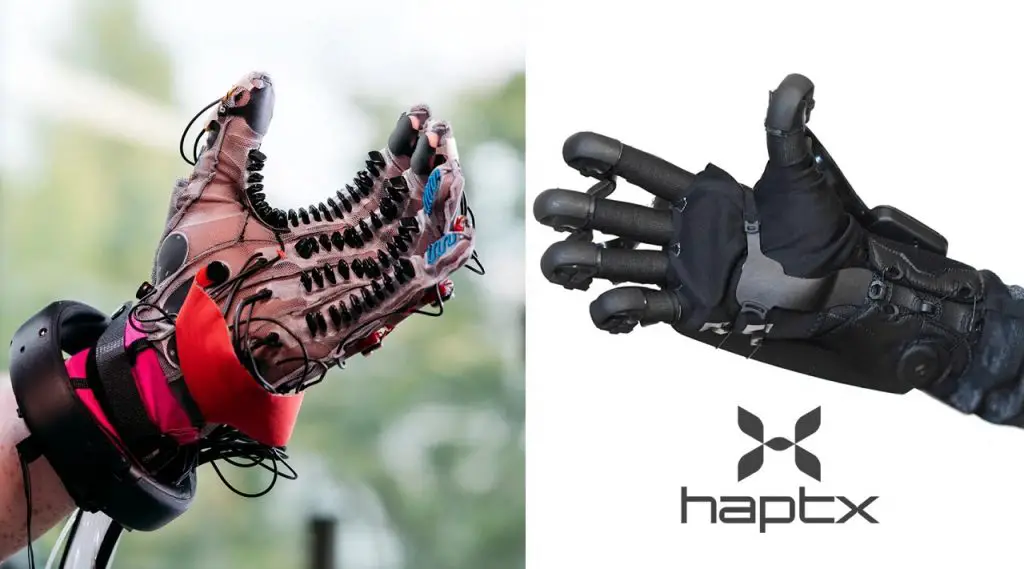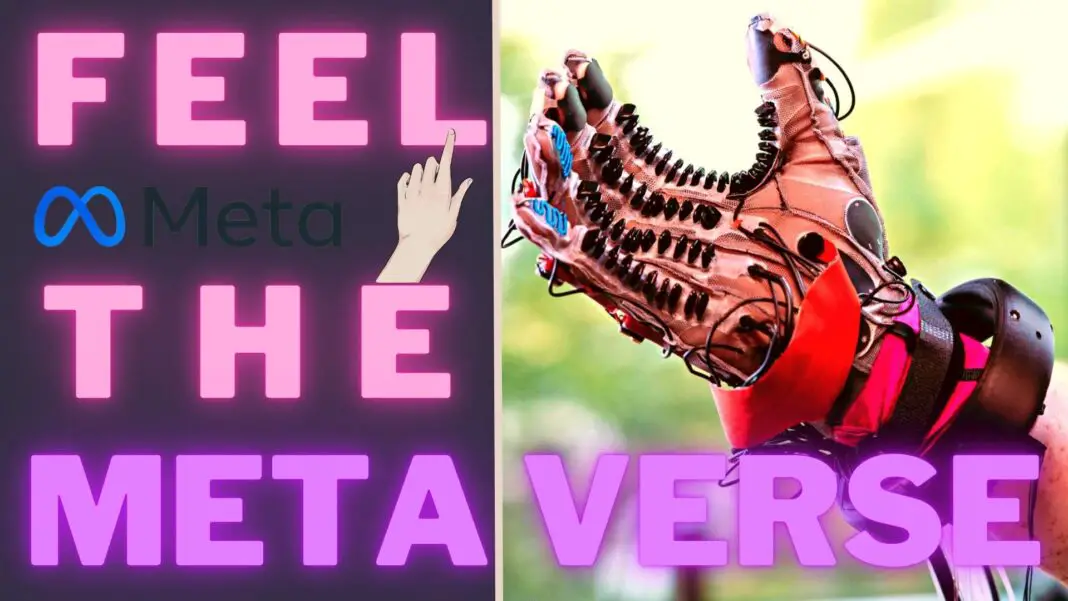META Unveils HAPTIC GLOVE That Can Mimic Touch In VR And AR | A Detailed CASE STUDY
This Is The One Stop Post For You To Understand What Are Haptics, What Are These Haptic Gloves, When Can We Expect Them To Launch, the Difference Between Vibrations, Hand Tracking And These Haptic Gloves, What Are The Main Challenges In Creating These Haptic Gloves That Can Mimic Touch In VR And AR And A lot More.
Meta wants to bring the sense of touch into the Metaverse; The research team’s goals could not be more ambitious: The data glove of the future.
The Reality Lab research branch has just unveiled a prototype haptic glove allowing users to imitate and have the feeling in virtual or augmented reality the sensation of picking up objects in the real world even when they are not.
These gloves would even go so far as to reproduce the texture of the virtual object touched. The objective is not (only) the video game but the integration of this kind of system for ever more immersion in the future metaverse of Meta.
All of this is under the following conditions: The glove should be soft, light, flexible, comfortable and resistant, look stylish, fit a wide variety of hands and be affordable for consumers. As you can see, the list of requirements is long.
We have put a lot of time into making this detailed illustrated-rich article for everyone to understand.
We’ve also added word meanings for some hard-to-understand words and also we have added “Table of contents” for you to directly jump onto the topic you want to gain knowledge or research about.
We hope that you’ll like this definitive post and sharing this post on your social media would mean a world to us.
Related:
How These 7 Industries Uses Virtual and Augmented Reality
What Is A Haptic Device?
So before diving deep into the whole “Haptic Gloves” topic, let’s first discuss, what is a haptic device?
We can call a haptic device, a hardware that brings us closer to an immersive experience in the world of Virtual Reality and Augmented Reality.
As an example, we have the vests that you can you see in the embedded video above.
These devices react with the virtual environment giving an instantaneous response to our body to make our skin feel what happens in the game.
Built-in Vibration V/S Hand Tracking V/S The Haptic Gloves
The Oculus controllers have a built-in vibration system that gives us feedback that we are interacting with an object.
And although it is a good and comfortable feeling, Meta wants to go even further by offering a more realistic response.
We currently have a hand tracking system in Quest that works really well.
Here are ALL the Oculus Quest 2 HAND TRACKING Compatible Games & Apps, if you want you can check them out.
The hand-tracking feature allows us to use and play games in VR without touch controllers, a great advance, but the next step is to be able to feel them.
For that, Reality Labs is investigating with the aim of launching gloves that are light, comfortable, affordable and durable.
These haptic gloves would offer us a much more realistic response creating sensations of pressure, texture, vibration and even weight.
See: How Nike Is Building Their Own Metaverse
How Much Time Will It Take to Develop the Haptic Gloves and When Can We Start Using These Devices?
To build this glove for future VR and AR applications, Reality Labs research director Sean Keller has set up a team of several hundred specialists over the past seven years.
Meta laboratories have wanted to make it clear that this type of research is projected in the long term and is a projection for a future that will extend for at least 10 more years.
Because there is still a lot of time and research to create a comfortable, affordable, and mass-produced haptic glove.
A long journey that is understood by the current technological barriers, which prevent the creation of haptic gloves simple enough to reach the domestic market.
So What Are the Challenges While Creating Haptic Gloves?
Now there are three core and main challenges that Meta is facing and are trying to solve before they start mass-producing these Haptic Gloves that can mimic touch.
First, making flexible materials for the haptic glove that can pass realistic haptics, the second, removing actuators and using micro-fluids.
And the third developing and inventing brand-new software with “Virtual Physics” to generate the feeling of “feeling” digital objects even when we’re not holding them.
So here are those 3 Three Things Meta’s Trying to Solve:
2. What and Why Using Micro-Fluids
3. Inventing brand-new software and Virtual Physics for these Haptic gloves
So let’s discuss these 3 core tasks in detail to get a better understanding of this topic.
1. New Materials: Smart Textiles and New Manufacturing
The main challenge for Reality Labs is getting soft and light gloves that manage to transmit complex sensations such as pressure, texture, or vibration.
And we also need them to be elegant, comfortable, affordable, durable, and customizable, the challenge ahead is mammoth.
The team is researching new, inexpensive plastics and “smart textiles” that will include conductive and capacitive functions that will give us maximum haptic precision as well as comfort without mechanical actuators.
Until now, these haptic gloves are loaded with mechanical actuators, which are responsible for transmitting the sense of touch to our hands.
The goal of Meta in terms of everything that refers to Virtual Reality follows 3 premises, the devices have to be comfortable, of good quality, and affordable for everyone.
For this reason, Reality Labs is working with comfortable, flexible, and personalized materials for each user to produce the best sensation.
2. Why Micro Fluids Are Important | Microfluidic Response
To greatly reduce the size of these devices, mechanical motors have been replaced by completely different technology with new materials.
According to Meta, they have made progress in pneumatic actuators that use air to create force feedback and other electroactive agents that generate an electric field that changes shape or size.
To control all this, Meta claims that it is building the world’s first high-speed microfluidic processor, generating responses in less than 1 second.
Among other things, it controls which valves open and how much to let air in or out.
Why Using Micro-fluids in the First Place?
The problem is that mechanical actuators generate too much heat, consume too much power, and are too stiff, large, and expensive.
The solution was to achieve mechanisms based on soft robotics and microfluidics.
With this microfluidic pressure system, they are getting responses in milliseconds.
In this way, it would be possible to eliminate mechanical actuators and achieve a very reduced size and weight that are relatively light, flexible, and energy-efficient and could one day be worn all day…
3. Inventing a Brand-new Software for the Haptic Glove in Short Meta Wants to Hack the Senses
The third challenge is to develop a completely new render software and physics for haptics that is able to convey the surface texture, weight, and hardness of virtual objects to the glove.
In addition to the complex hardware system, we will need the software which is capable to render the correct position of our hands
The UX Research department is taking advantage of the ability of the human brain to create convincing sensations, providing only a small amount of haptic, visual, and sound signals. In this way, we can really feel that a virtual object is really in our hands.
What’s Virtual Physics?
Another goal was to adapt virtual physics to that of the real world, tricking the brain into preventing the fingers from fully closing when trying to grasp a virtual object or the hands from traversing a virtual table when resting on its surface.
For this, the science of perception and multisensory integration were used, the study of how human senses work together to build our understanding of the world.
Haptic gloves have to be able to convince the user that the virtual object they have grasped has weight, is smooth or rough, is hot or cold, is cubic or spherical.
Our Opinion
The haptic gloves will be a true revolution in virtual reality. Being able to feel what we touch, being able to feel the weight of an object will make our immersive experience multiply enormously.
Suggested:
2 Methods – How To Play Skyrim VR On Oculus Quest 1 & 2
Sean Keller, Research Director’s Response on How Haptics Can Change the World We Live in
“The value of hands in solving the interaction problem in AR and VR is huge. We use our hands to communicate with others, learn about the world, and act within it. We can harness a lifetime of motor learning if we can bring full hand presence to augmented reality and virtual reality. People could touch, feel and manipulate virtual objects as if they were real objects, all without having to learn a new way of interacting with the world”
~ Sean Keller, Research Director, Reality Labs
But Is This Idea Original?

Shortly after the publication of Meta, HaptX, the leading company in this sector for a decade, made a statement about its supposed originality.
Jake Rubin, founder, and CEO of HaptX stated that Meta researchers and executives had visited HaptX on several occasions.
These visits were intended to see the patented technologies with the intention of sometimes collaborating between companies to advance this technology.
Read Next:
9 Ultimate Tips on How to Prevent Motion Sickness in VR Forever!
Conclusion
This is still very little explored terrain with a great future if we think about the possibilities of Mark Zuckerberg’s metaverse.
On the other hand, the leading company HaptX in haptic products has made known its dissatisfaction since Meta’s products are “substantially identical” to its patents.
It is a symbiosis between microfluidic actuators, with intelligent textile materials, which will make it possible for us to one day have the definitive haptic gloves.
At Reality Labs, they have been pioneers in new techniques and technologies for 7 years, and this is just the beginning.
We are looking forward to continuing to try everything that is to come and to tell you about it here, in the VR Marvelites’ Metaverse
What did you think of this article? Do you think that gloves can give us a realistic feeling of interactions with the virtual environment? Do not forget to leave your comment.
Read Next:
Alien Isolation VR – How To Play Alien Isolation In VR On Oculus Quest 1 & 2


